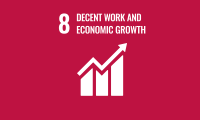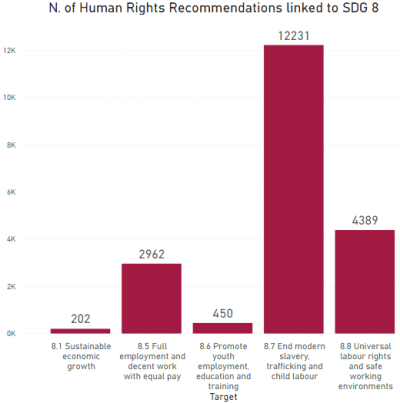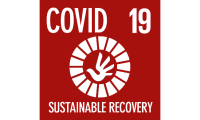SDG 8 and Sustainable Recovery

Key aspects of SDG 8:
1. Achieve decent work for all, equal pay for work of equal value, reduce unemployment, and support entrepreneurship and innovation (targets 8.3, 8.5, 8.6)
The pandemic has resulted in a global economic recession with historic levels of contraction of per capita income, unemployment and deprivation. The jobs and livelihoods crisis further deepen inequalities in the labour market and disproportionately affects already vulnerable groups without adequate social protections.
Particularly affected have been small and medium-sized enterprises, farm workers, precarious workers in the “gig economy” or the informal sector, refugees and migrant workers. Many of these also represent groups who face discrimination and who have no or limited access to social protection, economic security, sick leave, medical treatment, or to help to cope with lockdown. New business models, such as the platform and gig economy with non-standard employment relationships, also tend to reduce benefits and protection for workers.
Global employment during the pandemic declined more for women, youth and the medium- and – low skilled. Women accounted for 38.9% of the total employment before the pandemic but made up 47.6% of employment losses in 2020. Young people made up 13% of total employment before the pandemic but accounted for 34.2% of the 2020 decline in employment.
Women are more likely than men to be in the most vulnerable segments of the informal economy as domestic workers, home-based workers in the lower tiers of global supply chains, or as contributing family workers. As a result, they have few protections against dismissal, and little access to social protection including paid sick leave.
Because of pre-existing gender-based inequalities, women will likely experience more difficulty finding new jobs or entrepreneurship opportunities for their economic recovery.
Women also bear a disproportionate burden in the care economy. Prior to COVID-19, women did, on average, three times more unpaid care work than men, and this responsibility has increased significantly since the pandemic, given school and childcare closures and increased care needs of relatives.
Sustainable response and recovery actions:
Integrated policy responses aimed at mitigating job and income losses are required.
Immediate response measures should include providing income and food support to individuals and their families to compensate the loss of, or reduction in, economic activity, and to preserve employment. Ensuring access to safe, effective, quality and affordable vaccines for all can facilitate a safe reopening of the economy.
Longer-term measures should include: ensuring access to healthcare and financial protection for all; expanding social protection for workers in the informal economy and facilitating the formalization of informal enterprises to support the creation of decent jobs and contribute to poverty reduction; investing in jobs and livelihoods including creating jobs in emerging, more resilient and sustainable economic sectors; and, looking ahead, preparing the workforce with needed skills. Pay equity is essential to build back more equal.
Visit the documents and resources listed in the “Key Human Rights Guidance” below for more information.
Universal Declaration of Human Rights (UDHR), art. 23.1: “Everyone has the right to work, to free choice of employment, to just and favourable conditions of work and to protection against unemployment”.
Universal Declaration of Human Rights (UDHR), art. 23.2: “Everyone, without any discrimination, has the right to equal pay for equal work”
Universal Declaration of Human Rights (UDHR), art. 23.3: “Everyone who works has the right to just and favourable remuneration ensuring for himself and his family an existence worthy of human dignity, and supplemented, if necessary, by other means of social protection”.
International Covenant on Economic, Social and Cultural Rights (ICESCR), art. 7: “The States Parties to the present Covenant recognize the right of everyone to the enjoyment of just and favourable conditions of work which ensure, in particular:
7.a Remuneration which provides all workers, as a minimum, with:
7.a.i Fair wages and equal remuneration for work of equal value without distinction of any kind, in particular women being guaranteed conditions of work not inferior to those enjoyed by men, with equal pay for equal work.
7.a.ii A decent living for themselves and their families in accordance with the provisions of the present Covenant;”
International Covenant on Economic, Social and Cultural Rights (ICESCR), art. 6.2: “The steps to be taken by a State Party to the present Covenant to achieve the full realization of this right shall include technical and vocational guidance and training programmes, policies and techniques to achieve steady economic, social and cultural development and full and productive employment under conditions safeguarding fundamental political and economic freedoms to the individual”.
Convention on the Elimination of All Forms of Discrimination against Women (CEDAW), art. 13.b: “States Parties shall take all appropriate measures to eliminate discrimination against women in other areas of economic and social life in order to ensure, on a basis of equality of men and women, the same rights, in particular: […] (b) The right to bank loans, mortgages and other forms of financial credit”.
International Labour Organisation (ILO) C100 Equal Remuneration Convention: This fundamental ILO Convention requires ratifying countries to ensure the application to all workers of the principle of equal remuneration for men and women for work of equal value.
International Labour Organisation (ILO) C111 Discrimination (Employment and Occupation) Convention: This fundamental ILO Convention defines discrimination as any distinction, exclusion or preference made on the basis of race, colour, sex, religion, political opinion, national extraction or social origin, which has the effect of nullifying or impairing equality of opportunity or treatment in employment or occupation.
International Labour Organisation (ILO) C187 Promotional Framework for Occupational Safety and Health Convention: This ILO Convention requires ratifying states to promote continuous improvement of occupational safety and health to prevent occupational injuries, diseases and deaths, by the development of a national policy, national system and national programme.
International Labour Organisation (ILO) C155 Occupational Safety and Health Convention: The convention provides for the adoption of a coherent national occupational safety and health policy, as well as action to be taken by governments and within enterprises to promote occupational safety and health and to improve working conditions. This policy shall be developed by taking into consideration national conditions and practice. The Protocol calls for the establishment and the periodic review of requirements and procedures for the recording and notification of occupational accidents and diseases, and for the publication of related annual statistics.
International Labour Organisation (ILO) C87 Freedom of Association and protection of the Right to Organise Convention: This fundamental ILO Convention protects workers' freedom of association and right to organise.
International Labour Organisation (ILO) C98 Right to Organise and Collective Bargaining Convention: This fundamental ILO Convention concerns workers' right to organise and to collective bargaining.
International Labour Organisation (ILO) C29 Forced Labour Convention: This fundamental Convention requires ratifying states to suppress the use of forced or compulsory labour in all its forms within the shortest possible period.
International Labour Organisation (ILO) C105 Abolition of Forced Labour Convention: This fundamental ILO Convention requires ratifying states to take effective measures to secure the immediate and complete abolition of forced or compulsory labour.
2. Protect labour rights and ensure a safe and secure work environment (target 8.8)
Health and safety at work is a fundamental consideration for all workers in the context of the COVID-19 pandemic. Many healthcare workers, the majority of whom are women, have been infected as a result of inadequacies in, or shortages of personal protective equipment. Further, numerous categories of low-paid workers such as delivery workers, supermarket staff, refuse collection workers, manual labourers and agricultural workers have been exposed to heightened risks of being infected.
Sustainable response and recovery actions:
Immediate response measures should include reducing the exposure of workers and their families to the virus and the risks of contagion and ensuring that those infected have access to healthcare. Access to safe, effective, quality and affordable vaccines can lower health risks and secure a safe work environment. In the short term, income and employment protection should be accompanied by strengthening occupational safety and health measures and facilitating a safe return to service occupations. Governments and businesses must introduce the necessary protocols, including providing protective equipment, testing and medical care. Work arrangements should be adapted where possible (e.g. teleworking).
Sustainable response and recovery involve preventing discrimination and exclusion, providing access to social protection, including affordable health services, for all and expanding access to paid leave.
Visit the documents and resources listed in the “Key Human Rights Guidance” below for more information.
Universal Declaration of Human Rights (UDHR), art. 23.1: “Everyone has the right to work, to free choice of employment, to just and favourable conditions of work and to protection against unemployment”.
Universal Declaration of Human Rights (UDHR), art. 23.4: “Everyone has the right to form and to join trade unions for the protection of his interests”.
International Labour Organisation (ILO) 87: Art. 11: “Each Member of the International Labour Organisation for which this Convention is in force undertakes to take all necessary and appropriate measures to ensure that workers and employers may exercise freely the right to organise”.
International Labour Organisation (ILO) 98 art. 1. “Workers shall enjoy adequate protection against acts of anti-union discrimination in respect of their employment”.
International Labour Organisation (ILO) C100 Equal Remuneration Convention: This fundamental ILO Convention requires ratifying countries to ensure the application to all workers of the principle of equal remuneration for men and women for work of equal value.
International Labour Organisation (ILO) C111 Discrimination (Employment and Occupation) Convention: This fundamental ILO Convention defines discrimination as any distinction, exclusion or preference made on the basis of race, colour, sex, religion, political opinion, national extraction or social origin, which has the effect of nullifying or impairing equality of opportunity or treatment in employment or occupation.
International Labour Organisation (ILO) C187 Promotional Framework for Occupational Safety and Health Convention: This ILO Convention requires ratifying states to promote continuous improvement of occupational safety and health to prevent occupational injuries, diseases and deaths, by the development of a national policy, national system and national programme.
International Labour Organisation (ILO) C155 Occupational Safety and Health Convention: The convention provides for the adoption of a coherent national occupational safety and health policy, as well as action to be taken by governments and within enterprises to promote occupational safety and health and to improve working conditions. This policy shall be developed by taking into consideration national conditions and practice. The Protocol calls for the establishment and the periodic review of requirements and procedures for the recording and notification of occupational accidents and diseases, and for the publication of related annual statistics.
International Labour Organisation (ILO) C87 Freedom of Association and protection of the Right to Organise Convention: This fundamental ILO Convention protects workers' freedom of association and right to organise.
International Labour Organisation (ILO) C98 Right to Organise and Collective Bargaining Convention: This fundamental ILO Convention concerns workers' right to organise and to collective bargaining.
International Labour Organisation (ILO) C29 Forced Labour Convention: This fundamental Convention requires ratifying states to suppress the use of forced or compulsory labour in all its forms within the shortest possible period.
International Labour Organisation (ILO) C105 Abolition of Forced Labour Convention: This fundamental ILO Convention requires ratifying states to take effective measures to secure the immediate and complete abolition of forced or compulsory labour.
International Labour Organisation (ILO) C138 Minimum Age Convention: This fundamental ILO Convention sets the general minimum age for admission to employment or work.
International Labour Organisation (ILO) C182 Worst Forms of Child Labour Convention: This fundamental ILO Convention requires states to eliminate the worst forms of child labour; to provide direct assistance for the removal of children from the worst forms of child labour and for their rehabilitation and social integration.
Key Human Rights Guidance:
-
COVID-19 crisis and the informal economy, International Labour Organisation (ILO), Brief, 2020
-
Observations by ILO supervisory bodies on the ILO instruments (by convention and by country) – search page
-
Salient Human Rights Issues on Business and Human Rights, Danish Institute for Human Rights, website

Explore all Recommendations from human rights monitoring mechanisms linked to SDG 8 by country

